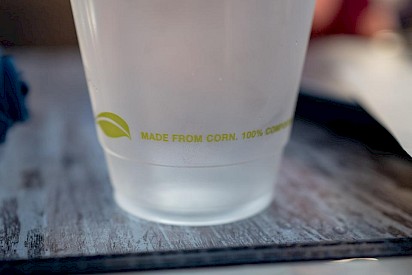The plastic alternative the world needs
 So, we all agree plastics are bad, right?
So, we all agree plastics are bad, right?
Plastics may be a villain in earth’s very own TV series, but without it, many inventions would not be possible today. Plastic has given us computers, solar panels, and even that iPhone you cannot live without.
However, traditional plastics are typically made from fossil fuels, and therefore contribute to the ongoing climate crisis. According to a UN Environment Program (UNEP) report, fossil fuel-based plastics alone account for an estimated 15 percent of the world’s carbon budget, equivalent to approximately 1.7 gigatons of CO2. Emissions from producing these harmful plastics are equivalent to 116 coal-fired power plants last year.
Fossil fuel-based plastic is also kind of immortal. These materials do not break down efficiently in the environment and end up sitting in landfills for hundreds and thousands of years; or they are burned with other trash, releasing toxic gas into the environment.
To make things more complicated, ‘greenwashing’ has become a troubling issue in recent years as companies attempt to use corn-based materials that they market as ‘compostable’. These corn-plastic products do not degrade as promised if they end up in forests or oceans.
However, there are startups trying to solve all of these problems by using innovative materials to make truly biodegradable products.
Unlike traditional plastic, bioplastics are typically made from renewable sources such as plants, starches, and sugars. One of the most advanced bioplastic materials is called PHA (Polyhydroxyalkanoates). It’s an excellent alternative to traditional fossil fuel-based plastic because it offers a completely compostable solution, biodegradable in all types of natural environments. Products made of PHA will completely decompose without any special treatment, which is crucial for preventing single-use plastic pollution.
For example, single-use straws made of traditional plastics can take up to 200 years to degrade on land or in the ocean. However, single-use straws made of PHA will degrade in just 90 days when buried in soil and 180 days in the ocean.
What About Our Oceans?
Preventing traditional plastics from entering the ocean is crucial to the health of our planet. For many decades, plastic has been improperly disposed of by society, which has caused plastics to build up in the ocean at an alarming rate. An Environmental Investigations Agency (EIA) study says that plastic will outweigh fish in the planet’s oceans by 2050. Since traditional plastics are made of petrochemicals and designed to be durable, their products are not naturally biodegradable and often contain harmful toxins. Unless these materials are removed by humans, plastic that ends up in the ocean will remain there indefinitely. Traditional plastic products have also been found to break down into microplastic. Marine animals sometimes eat microplastics, which in turn endangers human food safety by ending up on our plates.
PHA has been found to be one of the only bioplastics that will properly and efficiently break down in the ocean. Products made of PHA are denser than water, which means PHA is more likely to sink compared to other plastics. The soil at the bottom of the ocean helps with the biodegradation process and allows for the PHA to decompose faster than if it were to be free-floating. According to studies, the rate of degradation depends on the surface area of the product. Smaller products, such as straws, take just six months to disappear.
How is PHA Different from ‘Corn-Plastics’?
A more commonly recognized type of bioplastic is polylactic acid, or PLA, a material made from corn. Today, PLA (or corn-plastic) is made into single-use products such as straws, bottles, and other packaging materials. While PLA is technically considered ‘compostable’, products made of PLA need to be specially treated in industrial composting facilities in order to be properly biodegraded. This is because PLA needs to be heated to at least 140°F/60°C (a temperature that does not usually exist in nature) and fed special microbes to break the bioplastic back down into sugars.
Additionally, if PLA products are recycled, they must be separated as they will contaminate the recycling process. When tossed in the trash, PLA products can take 100 to 1000 years to completely degrade. Despite their marketing, this effectively makes PLA just as bad as traditional plastics.
Unlike PLA, PHA products do not need to be specially treated in order to break down. When PHA products are disposed, they will degrade in the natural environment.
Startups Pioneering Plastic Pollution Solutions
In recent years, a handful of startups have emerged to address the single-use plastic pollution problem. Companies like Full Cycle and Genecis focus on using food waste and agricultural byproducts to make PHA raw material. Refork developed a single-use fork by blending wood flour, PHA polymer, and minerals. Even more, OMAO leads in the development of naturally biodegradable tableware made from PHA. OMAO has replaced over 5,000 pounds of traditional plastics by offering PHA straws. The company is also working on other single-use tableware products in an effort to make sustainability even easier for everyone.
The plastic pollution problem looms, and it can often feel unaddressable because of its size and complexity. But it’s important to recognize that there are solutions out there for cleaning up our plastic use—and there are surely many more to come.
You can return to the main Market News page, or press the Back button on your browser.

